St Woolos Cemetery - The Haunted Holy Ground
From the book "The Haunted Holy Ground" by Mike Buckingham and Richard Frame published in 1988.
The Raging Elements - Earth and Water
By Mike Buckingham and Richard Frame
First published 1988
© Mike Buckingham and Richard Frame 2012
Even by the standards of a county in which mine disasters were part of the currency of existence, the collapse of the walls of the New Dock at Newport rated as a calamity of the first magnitude.
This was not something, which on that terrible day of July 2, 1909, happened in a mining village some way distant from the largest centre of population and, therefore, to a certain extent, out of sight and out of mind.
For the first time in many years, death of a large scale had come to the commercial and maritime heart of Newport, and when our great-grandparents met it face to face they did so with a mixture of horror and fascination.
Fate struck its terrible blow just as the fifty or so men working at the bottom of the trench which was to be the New Dock were about to go home. This is how the South Wales Argus of the day described what happened.
“It may be years since a calamity of such stupendous character visited Newport as that which occurred at the New Dock extension this afternoon,” it reported, in terms which a modern reader might see as a statement of the obvious.
“It involved the death of many men and injuries to others but it is probable that about forty were buried when the great fall occurred.
“Briefly, so far as can be gathered, what happened was this. The work of excavation for the west wing of the trench had been completed. It had been sunk to a depth of about fifty feet and was timbered from top to bottom and work of putting in the concrete was about to be commenced. Everything seemed to be ready for the second and more important stage of the operations and all apparently was well. There had been no signs of danger when suddenly, a few minutes before the day shift was due to leave, there came practically without warning a complete collapse of the whole structure of timber-work.
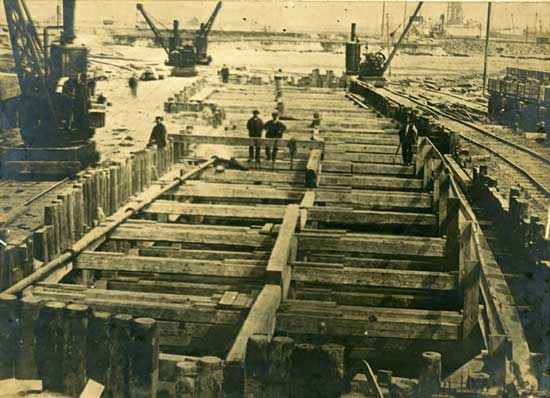
The trench just before it collapsed.
Photo courtesy of M Hunter whose great uncle, Oliver James English,
was killed in the tragedy.
“Under the tremendous pressure which is invariably exercised upon shorings in these deep cuttings the timbers suddenly proved incapable of bearing the strain. They rose and were forced together and the sides of the trench fell in, carrying with it the railway which ran each side, the travelling cranes and the trucks.
“At the bottom of the trench there were working some forty-six men. Those at the bottom had no chance whatsoever. A few men escaped but a large number were pinned beneath the fallen timber and there most of them remain.
“At the time the disaster occurred, one of the engineers, a Mr Faris, was on the spot. As he stood near the trench, he saw the timbers in the centre begin to lift. In a moment he recognised the danger of the situation and shouted.
“A few men sprang out and got clear. Mr Faris was thrown down and the working foreman was also involved and was injured. Immediately the disaster happened a signal was given to the whole of the men at the works that something exceptional had occurred and the engines sounded their whistles with long blasts. By this means attention was attracted.
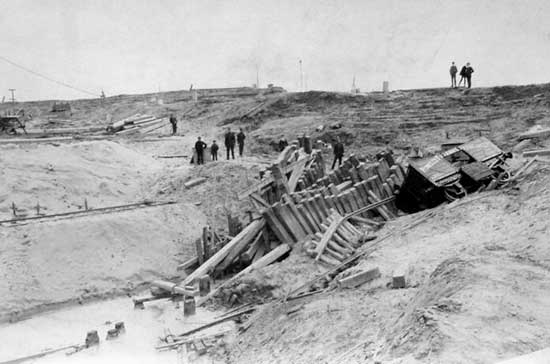
The scene after the trench had collapsed and flooded.
“Mr W. G. Cooper, the engineer in charge, at once jumped into an engine, made his way to the scene, and at once commenced to organise the rescue.
“The police were telephoned for as were also the medical men, and Dr Hamilton was the first to arrive. The news soon spread and hundreds of people made their way to the docks extension, many of these being willing to assist in the work of rescue, but this work was entrusted to experienced men.
“Mr Cooper got together the gangers on the work as well as the timber-men who were going on duty and together they proceeded to take the necessary precautions to prevent a crush of timber preparatory to undertaking the task for removal.
“Then cries were raised up in hopes of those imprisoned in the network of wood. Those within reach were attended to at once. Several men were brought out, one of whom was dead, while those still living were taken to hospital as soon as possible.”
These days we would find the Argus report a bit long-winded and short on description, but we have to remember that the reporters at the scene were writing in the afternoon for the same evening’s paper and were far away from any telephone. In any case, the lack of a sense of immediacy in the report was perhaps compensated for by the report of an interview with the busy Mr Cooper.
“The men had finished bottoming-up at one end of the trench,” said Mr Cooper, “and were due to start concreting tonight. The depth of the trench was about 50 feet and it was about 40 feet wide at one end and 30 feet at the other.
“The trench had been dug through part of the old bed of the River Ebbw, and at the top was sand which had been pumped there for the temporary dam. Below that there was the mud of the old river bed, below that again there was gravel and beneath that we had got to the solid rock. Both sides of the trench were shored with timbers fourteen inches thick. In fact it looked as if nothing could move it.
“As we sank the trench there had been no sign of movement at all. It was examined daily by the company’s engineer and by our representatives. I was down at the bottom myself two days ago and everything appeared to be quite safe. The timber has been designed on lines that were calculated to meet all strains and the men in charge of the contract had been in charge of some of the biggest contracts of this kind in England.
“Mr Faris, one of our engineers, was on the spot when he saw the timbers move. They seemed to move up in the middle and the whole thing went with practically no warning at all.
“We had a roll-call but we cannot say with certainty how many men were down there at the time of the accident. We believe there were about fifty men and I think we have accounted for 26, but some of the other men might have gone home.
“It was just before knocking-off time and it is possible that some of them might have escaped before the disaster occurred.”
The Argus reporters went on to describe the scene thus: “Four cranes had tumbled into the trench while dozens of wagons had fallen on their sides. The earth had slipped and there were huge cracks in the banks 25 yards from the trench. Boilers in cranes at the scene were put out so as not to ignite any possible gas seepage.”
In the following report, the Argus continued: “In one case it was possible to hand stimulants direct to a man, and refreshments were let down by means of a rope. The victims are at a great depth and a considerable time must necessarily elapse before the rescuers can get at them.”
We are left to imagine the scene on that terrible night, as men worked feverishly to reach workmates they could hear moaning, shouting and sobbing deep in the bowels of the earth.
Every so often, with sweat streaming down there faces, they would reach a cave where a timber had fallen leaving an angle which sheltered the men from the hundreds of tons of earth above. You will still hear talk of Newport’s “Boy Hero” Tom Lewis, who in going down into the trench to try to rescue the trapped men or give them supplies, captured the imagination of the country. Tom Lewis’s son still lives in Newport and a grandson lives just outside.
In fact, the Argus took the trouble to look into the background of the Boy Hero Lewis, whose bravery resulted in his being awarded a medal by the king.
It seems that his mother had died some years before and he lived with his grandmother at Baldwin Street, Newport. His remarried father was also employed at the dock. At the time of his outstanding act of heroism Tom was 17, a sturdy lad who was a keen footballer and a good singer.
All night Tom Lewis was diving in and out of that black chasm, and all night the sounds of the men, piteous to the ears, came up to reach the rescuers.
By ten o’clock at night, voices could be clearly detected, a fact which spurred the rescuers on to prodigious physical efforts. By the light of acetylene lamps they sweated and slaved, with men sinking back with exhaustion, only to have their pick and shovel picked up by another man who would work until he, too, reached the limits of his endurance.
By nine o’clock, two bodies were recovered, and more in rapid succession. A conversation between an Argus reporter and somebody trapped in the trench gave false hope of an incident less calamitous than it at first appeared. In a stop press, the Argus said: “By 9.30, four living men had been found in good hopes that they would be safely rescued before midnight. These men had been saved by the angle of timbers arching above them. Under the rubble the living men had dug towards where they could hear others.”
At around about the point when the four dead bodies had been recovered, the Western Mail took up the story and quoted an eyewitness as follows.
“There was a sudden overthrow. It was as if the earth had opened and swallowed everything — cranes, wagons, everything.
“I jumped for the concrete mixer and in doing so saved my life.”
The Western Mail, like its Newport rival, the Argus, quoted Mr Cooper, although clearly at a different time, as the quotes varied. In the Western Mail version he said: “The trench we were excavating was for the west wing wall of the foreshore at the outer end of the lock entrance. The men had finished bottoming out at one end and we were going to start concreting tonight. The depth of the trench was 50 feet and it was about 30 feet wide at one side and 40 wide at the other. The trench had been sunk through part of the old bed of the Ebbw River and at the top of the work there was sand which had been pumped there for a temporary dam.”
A Western Mail reporter, on arriving at the scene of the disaster, wrote: “When I arrived a hundred or more heroes were working on a mound of earth. Everywhere there were shattered vans, trucks and railway metals. Men were as busy as beavers, with perspiration upon every brow. An engineer of repute, who surveyed the scene by my side, expressed an opinion that a fortnight must elapse ere a fair idea of the death toll can be ascertained.
“The accident happened at 5.25. Five minutes more would have sufficed for every man to have been out of harm’s way, since at 5.30 the interval would have taken place.
“The man who knows more about the accident than anyone else is William William, driver of locomotive number 50, who resides at 8 Burnett Street, Newport.
“I happened to be on my engine,” he said, “and was working a load of trucks on the line which runs by the side of the job, when there was a loud noise and the ground began to give way.
“I could see that there was likely to be an accident so I sent up a long whistle as the signal for an accident. Then the ground near our rails began to give way and I steamed about as hard as I could to run the gauntlet ...”
A later report adds: “After the eye had become accustomed to the flare of the acetylene and naphtha lamps, after nearly an hour’s work in the gloom, a spectacle presented itself which will remain a haunting memory.
“Here and there and everywhere, men moved around in seemingly endless confusion, but a few moments observation revealed that there was orderliness in the rush. Every man had his appointed duty, dictated by an official, but the effect of the men’s work appeared to be terribly puny for the excavations on which they had been working before the collapse were very extensive.
“Holding a candle in one hand, one of the rescuers shouted down to a man called King: “Can you see the light?”
“Yes,” said the man. “I can see it all right but I can’t move, my hand is jammed between the timbers and I cannot move it. Oh, dear! I will have to have my arm cut off!”
“No, no, my boy!” was the cheering reply. “Keep your pecker up and we shall soon have you out!”
“Send me down a packet of cigarettes and a box of matches,” came the reply, but it could not be done.
And then: “I cannot bear the pain in my arm any longer. If I had a hatchet I would chop it off.”
The tragedy of that story is conveyed by the use of direct quotes, and it is perhaps the most poignant passage in all of the words which were written at the scene of the tragedy. The man, the same man who although in great pain had nevertheless been sufficiently aware of his surroundings to ask for cigarettes and matches was soon to sink from sight, to be drowned with the others who had survived the fall only to await the slow, creeping death brought by the rising water.
The Western Mail also carried the story of the Boy Hero Thomas Lewis, who, in their version, set to work with a chisel and saw some 30 feet down, and for two hours worked to rescue a man whose hand he could see.
Then, just had been the case with King, he slipped beneath the sodden earth, never to be seen alive again.
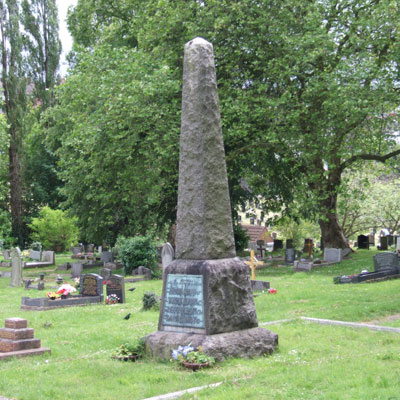
Obelisk erected on the spot where in a mass grave the 39 men are buried.
At St Woolos there is an obelisk erected on the spot where in a mass grave, the 39 dead men are buried. The names of each of them is cast on bronze plaques, together with this poem:
Soldiers of Industry, who fought so well
Against the powers of earth, and sea and sky
Beaten at last — crushed, shattered — where you fell
Deep buried in a mighty grave you lie.
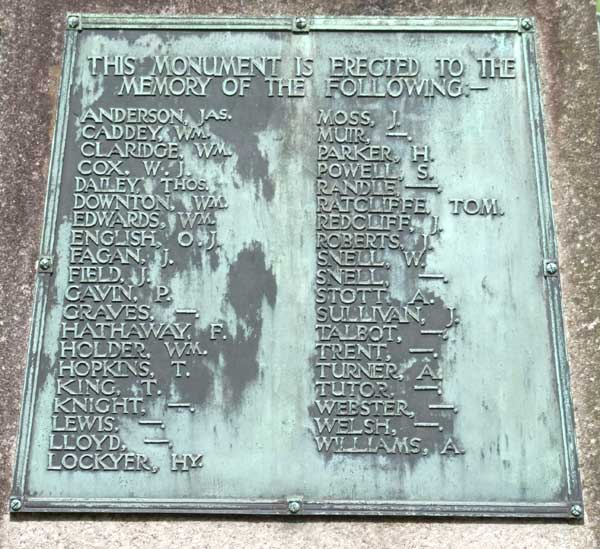
The names of the men killed in the Newport Dock Disaster are cast on a bronze plaque...
The grave was paid for by the contractors, as is reasonable to expect. What is certain is that the contractors were not subject to the same sort of scrutiny at the hands of the press they now would be were such a disaster, God forfend, to re-occur.
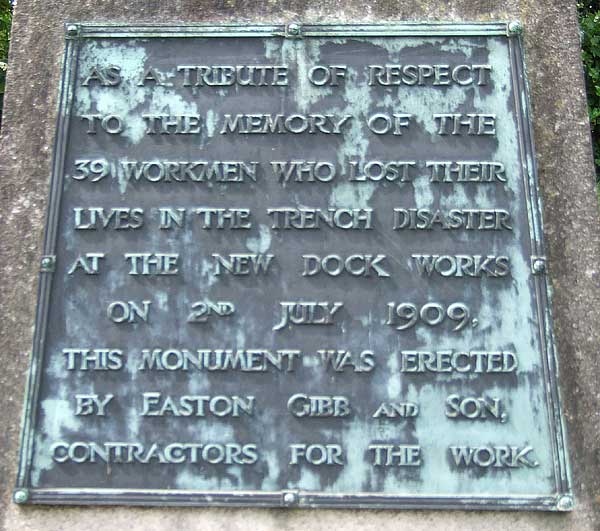
The grave was paid for by the contractors Easton Gibb and Son.
The year 1909 is still within living memory (written in 1988) but it was, nevertheless, a different world, in which the life of the working man was counted as cheap.
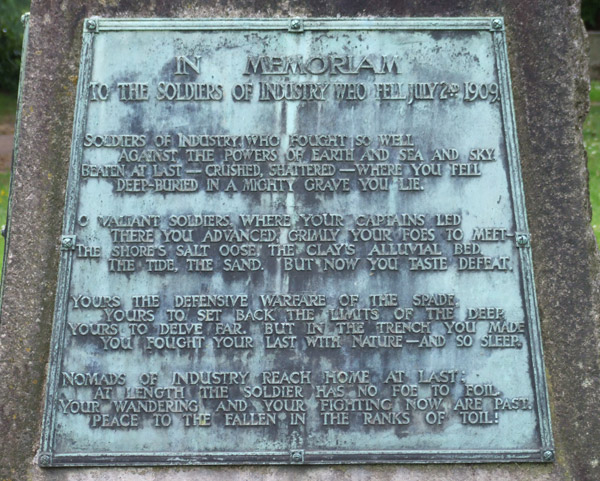
The poem on the third side of the Newport Dock Disaster memorial in St Woolos Cemetery, Newport, Mon.
It is interesting to note the tone of the Argus’s coverage, which seems to place more importance on the condition of the trench and its flanking cranes and railway than it does on the plight of the men.
You can still see the dock where this terrible tragedy took place. Even now it seems to be haunted by the souls of the men who died such appalling deaths.
So much news-space did the coverage take up in the columns of the South Wales Argus that there was relatively little space for another major story on the morning of July 3, the execution of a murderer at Usk Prison.
Normally, newspapers covered executions in some detail, but although a crowd of 500 colliers gathered outside the prison on the morning of the judicial killing of John Edmunds, sentenced for the killing of Mrs Cecilia Harris, there was little comment.
We are told that the crowd kept their eyes on a tarpaulin which had been used to cover the top of the scaffold and that from pinioning of the prisoner to the drop was a minute, but little more than that. Apart that is, from the fact that the famous Mr Pierrepoint was in attendance.
Precisely at the moment men were digging away with their picks, shovels and even their bare hands to rescue workmates, one man was being dropped into eternity at the end of a hempen rope.
The visitor to St Woolos these days might well reflect that even as recently as 1909 the life of a working man was held to be cheap.
Perhaps there should be an addition to the rather trite poem on the obelisk to the effect “never again”.
Except, of course, that there always is. Not in Newport, perhaps, but always somewhere.